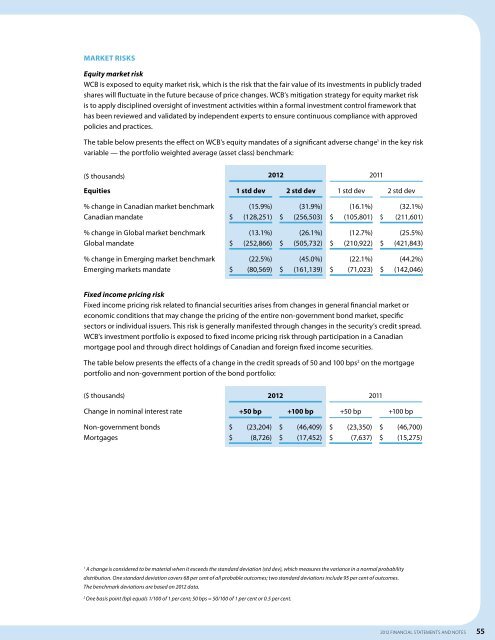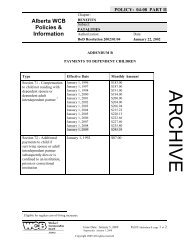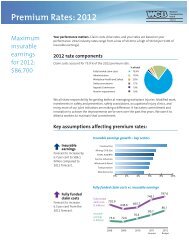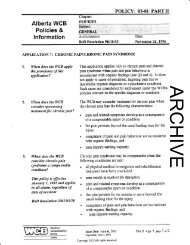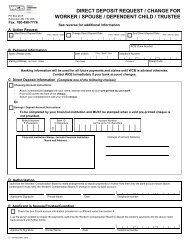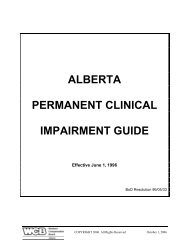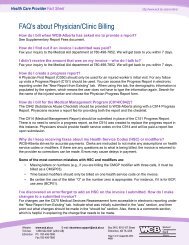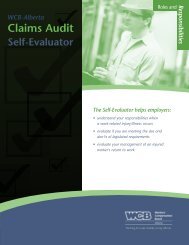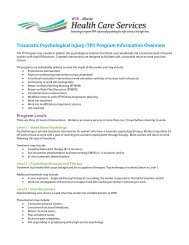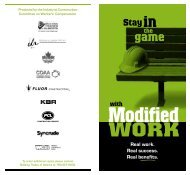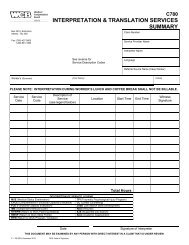2012 Financial Statements - Workers' Compensation Board
2012 Financial Statements - Workers' Compensation Board
2012 Financial Statements - Workers' Compensation Board
You also want an ePaper? Increase the reach of your titles
YUMPU automatically turns print PDFs into web optimized ePapers that Google loves.
Market risks<br />
Equity market risk<br />
WCB is exposed to equity market risk, which is the risk that the fair value of its investments in publicly traded<br />
shares will fluctuate in the future because of price changes. WCB’s mitigation strategy for equity market risk<br />
is to apply disciplined oversight of investment activities within a formal investment control framework that<br />
has been reviewed and validated by independent experts to ensure continuous compliance with approved<br />
policies and practices.<br />
The table below presents the effect on WCB’s equity mandates of a significant adverse change 1 in the key risk<br />
variable — the portfolio weighted average (asset class) benchmark:<br />
($ thousands) <strong>2012</strong> 2011<br />
Equities<br />
1 std dev<br />
2 std dev<br />
1 std dev<br />
2 std dev<br />
% change in Canadian market benchmark<br />
Canadian mandate<br />
(15.9%)<br />
$(128,251)<br />
(31.9%)<br />
$(256,503)<br />
(16.1%)<br />
$(105,801)<br />
(32.1%)<br />
$(211,601)<br />
% change in Global market benchmark<br />
Global mandate<br />
(13.1%)<br />
$(252,866)<br />
(26.1%)<br />
$(505,732)<br />
(12.7%)<br />
$(210,922)<br />
(25.5%)<br />
$(421,843)<br />
% change in Emerging market benchmark<br />
Emerging markets mandate<br />
(22.5%)<br />
$(80,569)<br />
(45.0%)<br />
$(161,139)<br />
(22.1%)<br />
$(71,023)<br />
(44.2%)<br />
$(142,046)<br />
Fixed income pricing risk<br />
Fixed income pricing risk related to financial securities arises from changes in general financial market or<br />
economic conditions that may change the pricing of the entire non-government bond market, specific<br />
sectors or individual issuers. This risk is generally manifested through changes in the security’s credit spread.<br />
WCB’s investment portfolio is exposed to fixed income pricing risk through participation in a Canadian<br />
mortgage pool and through direct holdings of Canadian and foreign fixed income securities.<br />
The table below presents the effects of a change in the credit spreads of 50 and 100 bps 2 on the mortgage<br />
portfolio and non-government portion of the bond portfolio:<br />
($ thousands) <strong>2012</strong> 2011<br />
Change in nominal interest rate<br />
+50 bp<br />
+100 bp<br />
+50 bp<br />
+100 bp<br />
Non-government bonds<br />
Mortgages<br />
$(23,204)<br />
$(8,726)<br />
$(46,409)<br />
$(17,452)<br />
$(23,350)<br />
$(7,637)<br />
$(46,700)<br />
$(15,275)<br />
1<br />
A change is considered to be material when it exceeds the standard deviation (std dev), which measures the variance in a normal probability<br />
distribution. One standard deviation covers 68 per cent of all probable outcomes; two standard deviations include 95 per cent of outcomes.<br />
The benchmark deviations are based on <strong>2012</strong> data.<br />
2<br />
One basis point (bp) equals 1/100 of 1 per cent; 50 bps = 50/100 of 1 per cent or 0.5 per cent.<br />
<strong>2012</strong> FINANCIAL STATEMENTS and notes 55


